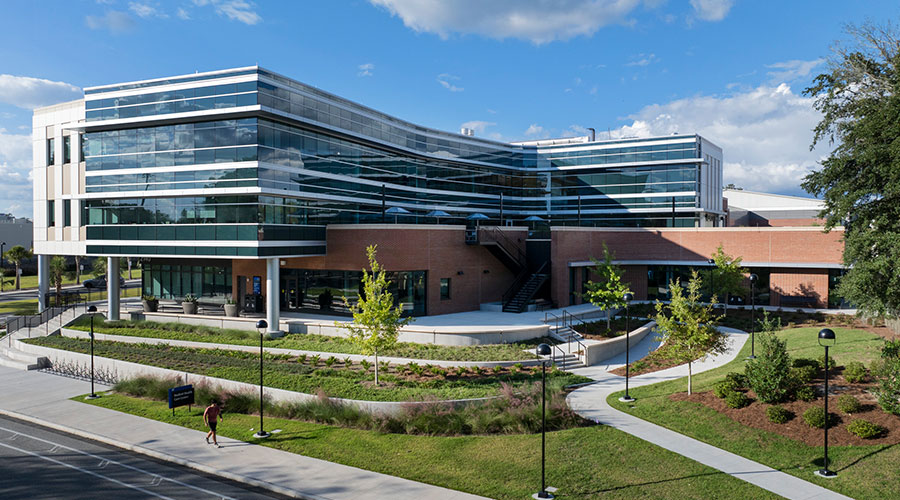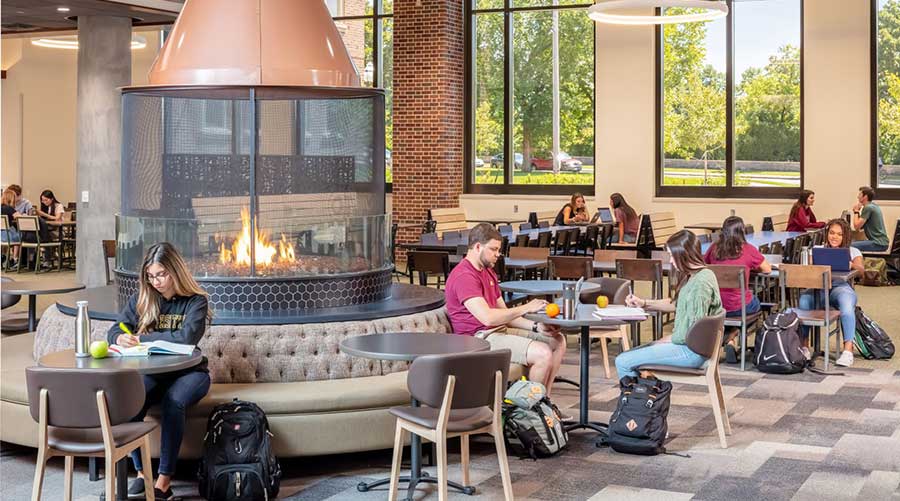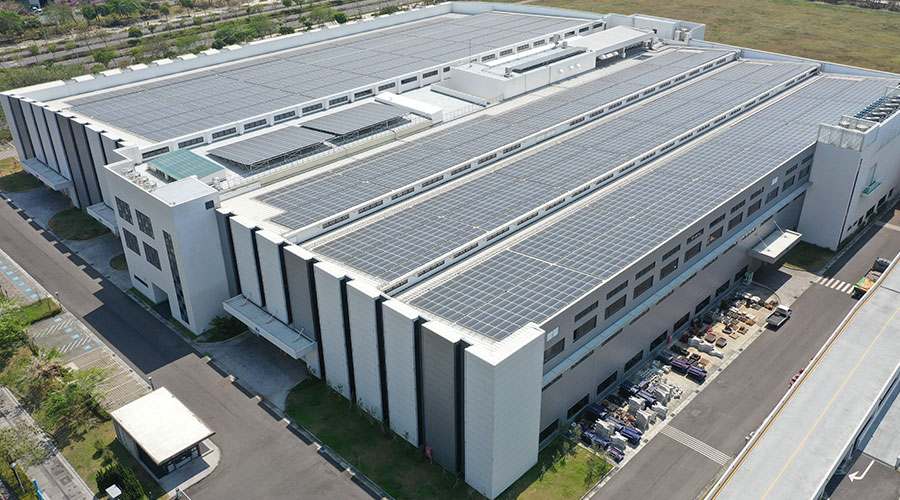University of Florida Earns WELL Platinum Certification
Student Health Care Center marks the school’s 100th green building and first school ever to receive top certification.
By Valerie Dennis Craven, Contributing Writer
The University of Florida is regarded as a top-tier public higher education institution. With an enrollment of more than 60,000 and a 97 percent retention rate, it consistently reaches single-digit rankings in lists featuring public universities and holds a slew of NCAA Division I championships and awards.
With the opening in early 2023 of the Student Health Care Center, the university holds another honor: WELL Certification at the Platinum level. This makes it the first of any university to reach the top level of certification offered by the International WELL Building Institute (IWBI).
The nearly 47,000-square-foot center houses Sports Medicine and Acute Care, Women's Health, Psychiatry, Primary Care, Physical Therapy, Laboratory, Radiology and Pharmacy. Students, staff and faculty can also receive immunizations and nutrition support, and the building holds administration and marketing services and conference rooms. The new center replaces an outdated infirmary that first opened in 1931.
While incorporating green building practices and certifying buildings through various programs isn’t new to the university, this is the first time it reached WELL certification, says Dustin Stephany, sustainable building coordinator with UF Planning, Design and Construction, the group that supports all physical facilities at the university.
“Because of the project-specific scope of being the Student Health Care Center, it really was a no-brainer for our upper management and leadership to really embrace this because it supports the mission of providing excellent health care services for our students and staff,” Stephany says.
Another higher educational building, at the University of Illinois at Urbana-Champaign, has since achieved WELL Certification at the Platinum level, highlighting the growing importance of creating healthy, supportive environments in the higher educational space.
“Achieving WELL Certification for the Student Healthcare Center is a big moment for the University of Florida and for universities across the country,” says Jason Hartke, executive vice president of External Affairs at the IWBI. “By deploying WELL strategies, the University of Florida is leading on health and creating an environment that helps students thrive, and we hope it inspires other campuses to do the same.”
Seeking certification
The infirmary had undergone multiple renovations since it was originally built for a student population of around 3,000 seeking inpatient services. It was time to replace the old and outdated building to meet and maintain current health care standards and practices.
University policy requires that any new building over $7.5 million must earn a green building certification.
“We have a rather robust policy in that the building has to meet at least a LEED certification of Gold or equivalent. We also already incorporate a lot of WELL features,” Stephany says.
Each building, project and certification program is unique, so finding the right fit is key.
“Being the sustainable building coordinator, my job is to understand these philosophical differences and listen to our clients and figure out what solution would be best for us that will have the greatest impact for generations to come,” Stephany says.
He isn’t exaggerating. The University of Florida typically designs buildings to be used for about 80 years. This means impact and use today and in the future are equally important. His team must consider how they can support educational excellence while providing flexibility as needs and expectations shift — from the university and its students and staff alike.
“We’re implementing policies like any new construction be solar ready,” Stephany says. “We don’t want to take away capital expenditures for the development of the new building to put solar on, but since we have the knowhow, let’s allocate some time to make sure that whenever it makes good fiscal sense, that now we have landing places to incorporate solar into our buildings.”
Pandemic lessons
Other flexibility considerations came out of the pandemic itself. With design and construction on the Student Health Care Center occurring during the early days of the COVID-19 pandemic, Stephany’s team was inspired to develop a building that could serve staff and students in a way that was previously unexpected.
The building can remain fully operational if there were another similar outbreak or pandemic. Some of the thoughtful details to accommodate shifting needs include:
- Overhangs on the outside of the building to accommodate for the six feet of distancing required during the COVID-19 pandemic
- No-contact pharmacy boxes outdoors for people to drop off and pick up items
- 100 percent outdoor air in the women’s health section of the building, providing air like that in a laboratory environment
- Ultraviolet lights and MERV filters in the air handlers, making indoor air quality at the university better than many homes
- Indoor native plants and snake grass to support air purification and biophilic response.
Additionally, the building was designed so it can structurally support additional floors on the building, expanding when space is needed.
“What’s very clear is that health care changes over time. We incorporated these flexibility principles into the space,” Stephany says.
Healthcare is a rapidly growing sector that’s adopting WELL’s health-focused strategies to improve staff, patient and visitors’ well-being, according to the IWBI. Globally, about 800 hospitals and healthcare facilities are implementing WELL’s health and wellness principles. Among health care organizations that are engaging with WELL, more than 70 have already achieved WELL Certification including 24 at the Platinum level.
IWBI also notes that many higher education institutions are increasingly embracing WELL Certification as part of their commitment to advancing student health and well-being.
Already meeting standards
When deciding on and applying for WELL Certification, the University of Florida team discovered that many of the requirements and practices were already in place at the institution.
“Going through the WELL Certification and understanding the requirements, we realized we are doing a lot of this through our green building certification momentum with different entities in the university,” Stephany says.
Through internal collaboration, the team at the university realized they could move beyond WELL Certification at the Gold level and apply for the highest honor, Platinum. Stephany credits the green efforts and teams already in place for this achievement.
“Every time we go through a new version of a certification program or a new program in general, it requires a lot of attention to detail,” he says.
The university’s Student Health Care Center was not only their first WELL Certified building, it was also their 100th green building project. And they have already registered another project for WELL, the Bruno E. and Maritza F. Ramos Collaboratory, an addition to the University of Florida College of Design, Construction and Planning.
As for the infirmary, it is getting a second life as a new college and being preserved in the process. It will include energy efficient windows; an updated tile roof, with the original tiles going to other campus projects; and materials donations to local schools and organizations.
A bonus for the university and green group going through its first WELL Certification is that they realized that with the policies and practices they already had in place, they meet the WELL Health-Safety Rating, so they will package this as part of new projects, Stephany says.
He credits the green team and university for prioritizing these efforts as to how they were able to reach triple digits in green projects, and WELL Certification altogether.
“This couldn’t have happened by just a few individuals, it’s taken a village,” Stephany says. “As people stepped into these roles, they embraced the mission of the Student Health Care Center and have the courage to do something that’s very different.”
While visitors might not notice specific features that were implemented because of the work for a WELL Certification, response to COVID-19 learnings or the university’s green efforts, “they know when they walk into a building, ‘Wow, this feels really nice in here,’” Stephany says.
While they can’t always put a finger on why, it’s the level of attention to detail that brings a sense of health and harmony to the experience.
Valerie Dennis Craven is a freelance writer based in Plymouth, Minnesota.
Related Topics:












